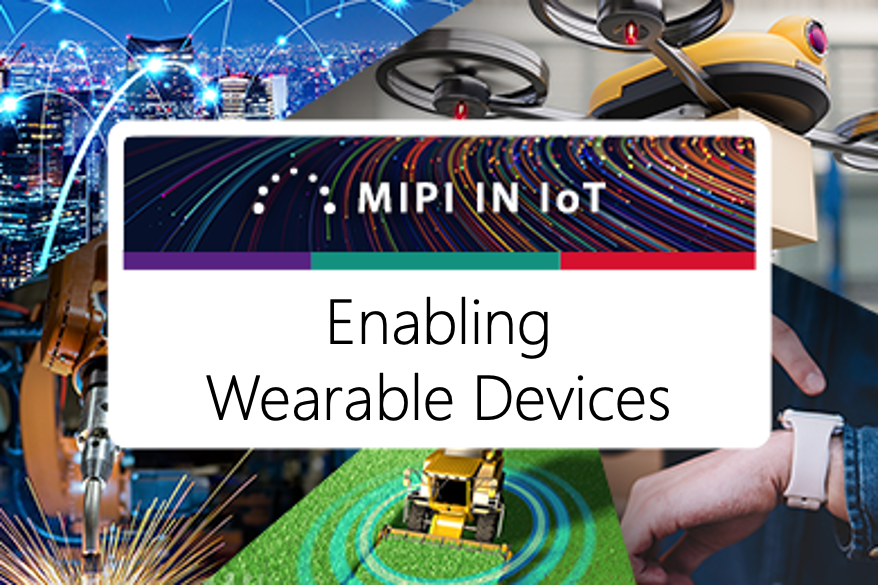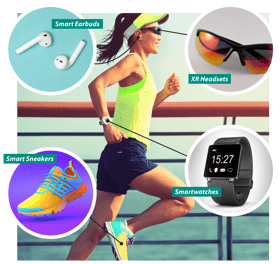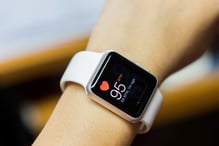4 min read
MIPI in IoT: Enabling Wearable Devices
![]() Ian Smith, MIPI Alliance Technical Content Consultant
:
18 March 2021
Ian Smith, MIPI Alliance Technical Content Consultant
:
18 March 2021

- News & Events
- News
- Blog
The scope of the Internet of Things (IoT) is vast, covering numerous consumer and enterprise market sectors. For a closer look at how MIPI specifications support growth in IoT, we're taking a look at a different IoT market sector each month. In this second post in the series, we’ll examine the use of MIPI specifications in connected wearable devices.
According to analyst predictions, worldwide end-user spending on wearable devices will total $81.5 billion in 2021, an 18% increase from $69 billion in 2020, largely driven by the rise in remote working and an increased interest in health monitoring during the COVID-19 pandemic. The market is forecast to increase by a further 15% in 2022, to over $93 billion per year.
What is a wearable? 
A wearable is a generic term that includes devices such as smartwatches, fitness trackers, ear-worn devices (earbuds and headphones), extended reality headsets, smart clothing and shoes, health monitoring devices (patches) and many other devices worn on the body.
The growth of the market is being driven by key industry trends including the development of ever smaller, integrated, low-power electronic components, the availability of 5G and other forms of localized wireless connectivity, and advancements in user interface (UI) design.
By connecting the human and digital worlds, for example, by enabling people to track and set health goals or more accurately monitor and control health conditions, wearables are generating huge volumes of data and providing new levels of insight into human behavior.
Benefits of MIPI specifications in wearable devices
MIPI Alliance develops and maintains interfaces and protocols to connect the key embedded electronic components (cameras, displays, sensors, communications modules) within devices. MIPI’s key interface specifications, conformance test suites, debug tools, software and other resources allow developers to create state-of-the-art, innovative devices—accelerating time to market and reducing costs.
Use of MIPI specifications provide key benefits for a variety of devices:
- Low-power devices, using constrained power supplies, will benefit from MIPI’s low-power interfaces that are interrupt driven, supporting low-power active and standby modes of operation
- Size-constrained, tightly packaged devices will benefit from MIPI’s low pin counts, low wire counts and low EMI interfaces
- Devices with wireless connectivity will benefit from MIPI’s 5G preparedness
- Safety critical devices, or devices that collect and process personal information, will benefit from MIPI’s functionally safe and secure interfaces
- MIPI’s associated software and debug resources will accelerate device design and development processes
Examples of MIPI specifications in wearable devices
The wearables market consists of a broad range of devices. We’ve highlighted a few examples below to demonstrate the wide applicability of MIPI specification within this market.
Smartwatches and Fitness Trackers

Smartwatches and fitness trackers usually consist of sensors, display, battery, memory and ECU components, and connect via local wireless connectivity to a hub device (usually a smartphone). Key requirements for these devices are the tight packaging of components to create small, light products, and the need for low power consumption to extend battery life in both active and standby modes of operation.
MIPI specifications that support the development of smartwatches and fitness trackers include:
- MIPI I3C® to provide a shared, two-wire interface to connect heart-rate, motion and other sensors and simple UI components such as LEDs and haptics
- MIPI DSI-2℠ to drive advanced high-resolution displays, enabling low-power display partitioning when devices are in low power mode
- MIPI C-PHY℠ physical interface to reduce line and pin counts and generating low EMI, allowing smaller devices requiring less EMC shielding
- MIPI SoundWire® to drive advanced audio components such as microphones and speakers
- MIPI Touch℠ to enable touchscreen UI
- MIPI RFFE℠ to control front end RF components for wireless communications
Earbuds and Headphones

Earbuds and headphones typically consist of speakers, microphone, battery, memory and ECU components and usually connect to a local host device (smartphone). It is becoming common for these devices to support advanced audio-based user interfaces based on edge computing, providing features such as keyword activation and digital assistants.
Like smartwatches and fitness trackers, key requirements include the tight packaging of components and the need for very low power consumption to extend battery life.
MIPI specifications that support the development of earbuds and headphone devices include:
- MIPI SoundWire to provide a shared, two-wire interface to drive high-quality speakers and microphones, enabling noise cancellation, low-power keyword activation and low-EMI operation to achieve tighter packaging of components with minimal EMC shielding
- MIPI I3C to provide a shared, two-wire interface, to connect sensors and simple UI components, such as LEDs and buttons
- MIPI RFFE to control front-end RF components for wireless communications
Healthcare Monitoring Devices
 Healthcare devices are key enablers for remote healthcare services that support independent living and drive better health outcomes. Examples include senior living monitoring devices that remotely monitor vital signs and provide movement and fall detection; diabetes monitors that continuously and unobtrusively check insulin levels and allow for precision treatment; and remote heart and blood pressure monitoring devices that remotely connect patients to their healthcare providers to monitor well-being and support treatment programs.
Healthcare devices are key enablers for remote healthcare services that support independent living and drive better health outcomes. Examples include senior living monitoring devices that remotely monitor vital signs and provide movement and fall detection; diabetes monitors that continuously and unobtrusively check insulin levels and allow for precision treatment; and remote heart and blood pressure monitoring devices that remotely connect patients to their healthcare providers to monitor well-being and support treatment programs.
MIPI specifications that support the development of wearable healthcare monitors include:
- MIPI DSI-2 to drive advanced, high-resolution displays, enabling low-power display partitioning when devices are in low power mode
- MIPI CSI-2® as highly scalable interface to connect advanced, high-resolution cameras, enabling low-power vision inferencing and machine vision
- MIPI C-PHY℠ and MIPI D-PHY℠ physical interfaces, reducing line and pin counts, generating low EMI and enabling smaller devices requiring less EMC shielding
- MIPI I3C to provide a shared, two-wire interface to connect heart rate, motion and other sensors and simple UI components, such as LEDs and haptics
- MIPI SoundWire to drive advanced audio components such as microphones, speakers and headsets, enabling audio for telemedicine applications
- MIPI Touch to enable touchscreen UI
- MIPI RFFE to control front-end RF components for wireless communications
XR headsets
Extended reality (XR) headsets encapsulate augmented reality (AR), virtual reality (VR) and mixed reality (MR) wearable devices. These typically consist of advanced displays, cameras, sensors, speakers, microphones, as well as battery, memory and ECU components, and usually connect to a local host device (smartphone or gaming device).
Key requirements for these devices are the need to create an immersive low-latency user experience using high-resolution displays, advanced movement sensors and high-definition audio.
MIPI specifications that support the development of XR headsets include:
- MIPI DSI-2 over MIPI C-/D-PHY to drive advanced, high-resolution displays, enabling low-power display partitioning when devices are in low power mode
- MIPI CSI-2 over MIPI C-/D-PHY to connect a high-resolution camera, enabling low-power vision inferencing
- MIPI SoundWire to provide a shared, two-wire interface to drive speakers and microphones, enabling noise cancellation, low-power keyword activation and low-EMI operation to achieve tighter packaging of components with minimal EMC shielding
- MIPI I3C to provide a shared, two-wire interface to connect sensors and simple UI components, such as LEDs and haptics
- MIPI RFFE to control frontend RF components for wireless communications
Learn More
For more information on how MIPI specifications are enabling connected wearable devices and to see examples of other IoT use cases, download the recently published white paper; "MIPI Alliance: Enabling the IoT Opportunity."
You can also access the MIPI DevCon 2020 IoT presentation and closing chat session to hear from industry experts about the growth of IoT, market trends and the role of MIPI specifications in supporting connected devices.






